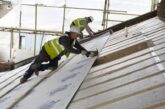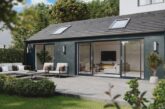
Professional Builder’s Edward Kelly interviews Professor Will Swan, Director of Energy House Labs at the University of Salford about Energy House 2.0, energy efficiency in building and the Future Homes Standard.
The Future Homes Standard 2025, much like Net Zero 2050 ambitions, is one of the hot topics in the construction industry. Increasing the energy efficiency of our housing stock should be a win-win all round, helping our planet and reducing energy bill costs. It is, of course, not as simple as that though. What’s to say this new standard is even attainable for the average SME housebuilder out on site? Looking at answering this is the University of Salford and Energy House 2.0.

Energy House 2.0
Energy House 2.0 is a research facility in Salford with two environmental chambers inside, each able to accommodate two detached houses. Conditions can be controlled in these chambers, with the ability to set temperatures between -20˚C to +40˚C and simulate different weather conditions like wind, rain and solar radiation. There’s even an Alpine quality snow machine which Professor Will Swan assures me is bags of fun. (Snowball fight anyone?)
Professor Will Swan is Director of Energy House Labs at the University of Salford, the team responsible for Energy House 2.0. Professor Swan explains: “What we’re really interested in is anything to do with domestic energy use.
“We really cover everything right the way from fabric and insulation materials, doors and windows to gas boilers and air source heat pumps” Measuring is the game here and it’s what the Energy House Labs are famous for.

The facility was completed in February 2022 and the houses in Chamber 1 were then finished in January 2023. This chamber is host to The Future Home from Bellway and eHome2 from Barratt/Saint Gobain, which researchers have been thoroughly testing for just over a year now. Both are three-bedroom homes, built using high performing, efficient fabrics. These fabric options (like the glazing for example) can be interchanged and updated. There’s multiple heating, hot water, and renewables systems that can easily be “switched” too, letting researchers and manufacturers play around. “We could do a repeatable experiment and that’s enormously powerful. So, we could test the house as it was, do something to it, test it again, take one away from the other, in a sort of very lay scientific term, and you would have the thing that made the difference.” Professor Swan summarises.
Future Homes Standard
While the Future Homes Standard hasn’t been revealed in full as of yet, the current government consultation for the Future Homes Standard does define some features that homes built to this standard will have. This standard will require new homes to be future proofed, have low carbon heating systems and high levels of fabric efficiency. Updates in 2022 to the Building Regulations, specifically Approved Document Part L, F and O, were meant to function as a stepping stone to the upcoming Future Homes Standard. The expectation is that the new standard will increase these changes meaning new build homes will have to generate 75% less carbon emissions than those built under the 2013 regulations.
The two houses built in Energy House 2.0 were built trying to emulate this new standard as much as possible. While the exact details of how these two houses did so are available in the recently released fabric reports, the general idea is to optimise heat loss and air permeability and use newer heating systems like air source heat pumps. The Energy House Labs team measured how the overall build and individual elements of the houses measured up against design predictions with these factors.

Professor Will Swan explains the results: “I think what we’ve seen first things first is the Future Home Standard is achievable. It’s achievable, and the technology is there to do it. I think it shows that with good site management, and good design, it’s clearly doable.
“Policy makers will sometimes come up with a set of regulations, but actually having something to show them and to say, look, this is the outcome of your policy is really, really useful.”
The fabric reports were positive for both homes, with a small performance gap of up to 8% between the anticipated and actual performance. (Some homes can have as big of a performance gap as 140%!)

Professor Swan explains that these results showing that 8% is actually a positive for the industry. “Making those (the reports) publicly available for everybody to say, look, this is how you do it, warts and all, or this is how you don’t do it depending on the results, is a really valuable lesson for industry because it’s not something I think we’re always very good at doing in terms of the sector. It’s sharing not just great news but also where we can improve.”
Supporting SMEs
Having clear information publicly available is something Professor Swan highlights as key to achieving the Future Homes Standard on mass (as well as government tackling of the skills and supply shortages).
“The information is starting to come out, but it’s actually putting it in people’s hands, not in the form of a big, ‘here’s a bunch of U values’ but actually ‘this is what you do’.
“I’ve worked around the construction industry a long time and they learn by doing, they’re what they call kinaesthetic learners and they’re problem solvers. So actually, what they want is a set of rules of thumb.”
For more on Energy House 2.0 and to listen to the full interview with Professor Swan check out the episode of the Professional Builder Podcast here: Episode 11 – Energy efficiency and the Future Homes Standard – Professional Builder (probuildermag.co.uk).
You can read the fabric reports for The Future Home and eHome2 here: Energy House Labs | University of Salford.







